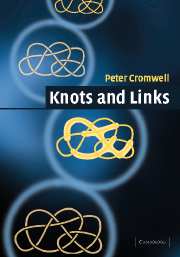Book contents
- Frontmatter
- Contents
- Preface
- Notation
- 1 Introduction
- 2 A Topologist's Toolkit
- 3 Link Diagrams
- 4 Constructions and Decompositions of Links
- 5 Spanning Surfaces and Genus
- 6 Matrix Invariants
- 7 The Alexander–Conway Polynomial
- 8 Rational Tangles
- 9 More Polynomials
- 10 Closed Braids and Arc Presentations
- Appendix A Knot Diagrams
- Appendix B Numerical Invariants
- Appendix C Properties
- Appendix D Polynomials
- Appendix E Polygon Coordinates
- Appendix F Family Properties
- Bibliography
- Index
10 - Closed Braids and Arc Presentations
Published online by Cambridge University Press: 05 June 2012
- Frontmatter
- Contents
- Preface
- Notation
- 1 Introduction
- 2 A Topologist's Toolkit
- 3 Link Diagrams
- 4 Constructions and Decompositions of Links
- 5 Spanning Surfaces and Genus
- 6 Matrix Invariants
- 7 The Alexander–Conway Polynomial
- 8 Rational Tangles
- 9 More Polynomials
- 10 Closed Braids and Arc Presentations
- Appendix A Knot Diagrams
- Appendix B Numerical Invariants
- Appendix C Properties
- Appendix D Polynomials
- Appendix E Polygon Coordinates
- Appendix F Family Properties
- Bibliography
- Index
Summary
In this chapter we give space a book-like infrastructure of pages attached to a binding. This enables us to study links in two complementary ways: aligned within the pages or running transversely to them. This provides two new geometric link invariants, lower bounds for which can be obtained from the 2-variable link polynomials F(a, x) and P(v, z).
First, then, let us define the infrastructure. Think of ℝ3 as ℂ × ℝ with coordinate system (r, θ, z). The z-axis will be the binding for the book. Using polar coordinates in the complex plane rather than the standard cartesian ones makes it simpler to describe the pages. For a fixed value of θ the set Hθ = {(r, θ, z) ∈ ℝ3} is the half-plane at angle θ. As θ ranges from 0 to 2π these half-planes fill space – they are the pages of an open-book decomposition of ℝ3.
If we add the point at infinity to form S3 = ℝ3 ∪ {∞} then the binding becomes the circle z-axis ∪ {∞} and the pages become discs. In both ℝ3 and S3, if we remove the binding, we are left with a space homeomorphic to an open solid torus, and the pages are just the meridional discs.
Braid presentations
In §7.10 we met a special form of n-tangle, called a braid, in which all the strings descend monotonically.
- Type
- Chapter
- Information
- Knots and Links , pp. 241 - 285Publisher: Cambridge University PressPrint publication year: 2004
- 1
- Cited by



